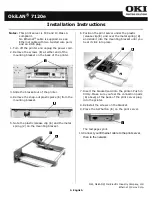
4
Chapter 2
Installation and Setup
Requirements
•
Ethernet Network employing 10BaseT or 100BaseTX.
•
TCP/IP protocol.
Installation
1. Connect Network Cable
Use the RJ45 socket to connect the Disk Server to your Hub. The Disk Server will auto-configure for
10BaseT or 100BaseTX, and full or half duplex.
2. Connect Printer
Use a standard printer cable to connect the Disk Server's parallel port to the printer.
3.
Connect Power
Use the supplied power cord to connect the Disk Server to a power outlet, and power ON using the
power switch on the rear.
4. Check the boot process
q
During the self-test (2 or 3 seconds), ALL of the LEDs will be ON.
q
Then, while the Disk Server is booting, the
Ready
,
Error
, and
Disk Full
LEDs will be ON.
q
Once the boot process is completed, the
Ready
LED should be ON and the
Error
LED should be
OFF.
q
If the
Error
LED stays On, there is a hardware problem. Repeated beeps also indicate a failure to
boot correctly.
Disk Server Setup using Windows
•
For basic operation, only the following setup is required.
•
For the full range of options available to the Network Administrator, refer to
Chapter 3 - Administration
.
Installation
1. Insert the supplied CD-ROM into the drive of your Windows 95/98/NT4.0.0 system.
2. If the SETUP program does not start automatically, run SETUP.EXE in the root directory.
3. Follow the prompts to install the
Disk Server Utility
.
Using the Disk Server Utility
1. Start the program. For the default installation, use
Start - Programs - Disk Server - Disk Server
Utility
.
2. The screen will look like the example below. The left section displays a list of all Disk Servers. The
right section displays data about the currently-selected Disk Server. (If no Disk Servers are listed, see
the
Troubleshooting
section.)
Summary of Contents for NAS-1000
Page 1: ...i NAS 1000 Disk Server User s Guide ...
Page 4: ......









































